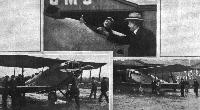
Описание
Страна: Великобритания
Год: 1919
A.Jackson British Civil Aircraft since 1919 vol.3 (Putnam)
The Martinsydes
<...>
Although incorporating many F.4 components, the Falcon powered Martinsyde Type A Mk.I long-range two seater G-EAMR was a two bay biplane considerably larger than its predecessor, built in 1919 to compete for the Australian Government’s £10,000 prize for the first England-Australia flight. It fared no better than F. P. Raynham’s unregistered Martinsyde Raymor, an essentially similar Falcon III powered machine which had crashed in Newfoundland on 17 July 1919 while he was taking-off for an attempted transatlantic flight. Capt. С. E. Howell and his navigator, Cpl. G. H. Fraser, left Hounslow in G-EAMR on 12 December 1919 but after making good progress were drowned when forced down off the west coast of Corfu five days later.
Fitted with floats the Type A became the Type AS, two of which, G-CAAX and ’DG, were acquired by Price Bros. Ltd., Quebec in July 1920 for timber survey and fire patrol work but their careers were brief for ’AX crashed at Lake Onatchiway on 18 August and 'DG at Chicoutimi on 30 May 1921.
A second version, seating four passengers in side-by-side pairs in a glazed cabin ahead of the pilot, was designated Type A Mk.II. No market existed at home and only the first of the four built, G-EATY, was of British registry. All were exported, the first, with C. of A. issued to R. H. Nisbet on 27 May 1921 for shipment to Price Bros. Ltd. as G-CAEA to replace ’DG, spun in at Chicoutimi on 12 July 1923 while in service with the Dominion Aerial Exploration Co. Ltd., Toronto. G-EATY and an unregistered example were sold to F. S. Cotton's Aerial Survey Co., equipped with radio, cameras and interchangeable ski undercarriages for seal spotting in Newfoundland. One took part in the gold rush at Stag Bay, Labrador, in 1921. The final Martinsyde Type A Mk.II, also unregistered, christened ‘The Big Fella’ and delivered from Brooklands to Baldonnel for the Irish Air Corps on 16 June 1922, remained in service until 1927.
<...>
SPECIFICATION
Manufacturers:
Martinsyde Ltd., Maybury Hill, Woking, and Brooklands Aerodrome, Byfleet, Surrey; The Aircraft Disposal Co. Ltd., Regent House, Kingsway, W.C.2, and Croydon Aerodrome, Surrey.
Power Plants:
(Martinsyde Type A Mk.I)
One 275 h.p. Rolls-Royce Falcon III.
(Martinsyde Type A Mk.II)
One 300 h.p. Hispano-Suiza.
Type A Mk.I and Mk.II
Span 43 ft. 4 in.
Length 29 ft. 1 1/4 in.
Height 10 ft. 6 in.
Wing area 512 sq. ft.
Tare weight 1,800 lb.
All-up weight 4,600 lb.
Maximum speed 125 m.p.h.
Cruising speed 100 m.p.h.
Initial climb 650 ft./min.
Ceiling 16,000 ft.
Duration 5 hours
Production:
(d) Martinsyde Type A
Four Mk.I aircraft only: (c/n E4-500*) G-EAMR; (15/1) G-CAAX; (15/2) G-CADG; (E4-500*) G-EAPN.
Four Mk.II aircraft only: (c/n 215) Cotton, Newfoundland; (216) G-CAEA; (217) Irish Air Corps ‘The Big Fella', believed reworked version of Type A Mk.I G-EAPN; (218)G-EATY.
* As documented. Not the same aircraft.
Описание:
- A.Jackson British Civil Aircraft since 1919 vol.3 (Putnam)
- Журнал Flight
Фотографии
-
A.Jackson - British Civil Aircraft since 1919 vol.3 /Putnam/
The ill-fated Martinsyde Type A Mk.I leaving Hounslow for Australia, 12 December 1919.
-
Журнал - Flight за 1919 г.
Three-quarter front view of the Martinsyde-Rolls-Royce "Raymor"
-
Журнал - Flight за 1919 г.
THE "RAYMOR." - Running the engine of the Martinsyde-Rolls-Royce Transatlantic machine
-
Журнал - Flight за 1919 г.
The Martinsyde plane, "Raymor," at St. John's, Newfoundland, in which Capt. W. Morgan, R.N., R.A.F., is attempting a Transatlantic flight. Capt. Morgan is seated in his machine ready for a trial flight
-
P.Lewis - British Racing and Record-breaking Aircraft /Putnam/
The red and yellow Martinsyde A The Raymor which crashed at Quidi Vidi, Newfoundland, on 18 May, 1919, when F. P. Raynham and Capt C. W. F. Morgan were taking-off on their attempt to fly the North Allantic.
-
Журнал - Flight за 1919 г.
THE MARTINSYDE MACHINE ENTERED FOR THE FLIGHT TO AUSTRALIA: Three-quarter rear view
-
Журнал - Flight за 1919 г.
THE AUSTRALIAN FLIGHT: On the left, the start from Hounslow of the Martinsyde 'plane on December 4. "Goodbye-ee!" At top: Mr. Nesbit of the Martinsyde firm wishes good luck to Capt. C. E. Howell on his journey. On the right: The Martinsyde 'plane gets away at 9.35 a.m.
-
A.Jackson - British Civil Aircraft since 1919 vol.3 /Putnam/
G-EATY, sole example of a Martinsyde Type A Mk.II in British civil markings.
-
A.Jackson - British Civil Aircraft since 1919 vol.3 /Putnam/
The Martinsyde Type A Mk.II commercial seaplane G-CAEA on the Saguenay River, P.Q., Canada in 1921.
-
P.Jarrett, K.Munson - Biplane to Monoplane: Aircraft Development, 1919-39 /Putnam/
Spectators race to the scene at St John's, Newfoundland, on 18 May 1919, moments after test pilot F P Raynham, with navigator Captain C W F Morgan, crashed in the Martinsyde Raymor while taking off to attempt the first direct Atlantic air crossing
-
Журнал - Flight за 1919 г.
THE MARTINSYDE-ROLLS "RAYMOR." - Plan, side and front elevations to scale
-
Журнал - Flight за 1919 г.
THE MARTINSYDE MACHINE ENTERED FOR THE ENGLAND-AUSTRALIA FLIGHT: Plan, side and front elevations to scale
-
Журнал - Flight за 1919 г.
THE FLIGHT TO AUSTRALIA: Side elevation of the Martinsyde machine fitted with floats for the last stages of the journey
-
A.Jackson - British Civil Aircraft since 1919 vol.3 /Putnam/
Martinsyde Type A Mk II














